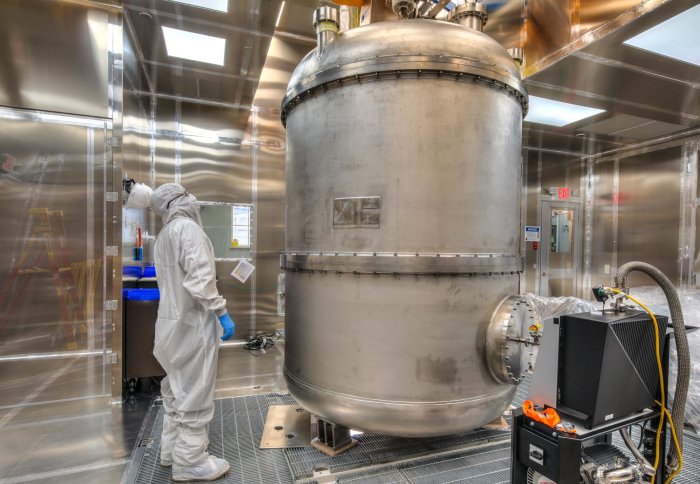UK delivers super-cool kit to aid the global hunt for dark matter

The huge titanium chamber, designed to keep its contents at -100C, is a crucial part of a new experiment hoping to detect dark matter.
Dark matter is the as-yet-unknown substance that makes up about 85% of the mass of the universe. Scientists think the reason they have been unable to detect it so far is that it is made primarily of ‘Weakly Interacting Massive Particles’ (WIMPs), which don’t interact very much with normal matter.
It is incredibly gratifying to see LZ beginning to take shape. Seeing the cryostat arrive is a milestone moment as it has been years in the making. Professor Henrique Araújo
The quest to find out what dark matter is made of, or whether it can be explained by a new particle rather than by tweaking the known laws of physics, is considered one of the most pressing questions in particle physics, which Imperial College London researchers are involved in.
The new chamber, called a ‘cryostat’, was developed by the UK. The cryostat is a vital part of the new LUX-ZEPLIN (LZ) experiment, as it keeps the detector at freezing temperatures. This is crucial because the detector uses xenon, which at room temperature is a gas. But for the experiment to work, the xenon must be kept in a liquid state, which is only possible at around -100C.
Ground-breaking facility
The UK principal investigator for LZ is Professor Henrique Araújo from the Department of Physics at Imperial. He said: “It is incredibly gratifying to see LZ beginning to take shape. Seeing the cryostat arrive is a milestone moment as it has been years in the making.
“Now we have to wait for the other constituent elements to arrive before we can start to see some exciting science taking place at this ground-breaking facility.”
Because WIMPs are thought not to interact easily with normal matter, they are practically invisible using traditional detection methods. Liquid xenon, however, emits a flash of light when struck by a particle, and this light can be detected by very sensitive detectors called photomultiplier tubes. If a WIMP collides with a xenon nucleus, researchers expect it to produce a tiny burst of light.
The experiment will use 10 tonnes of liquid xenon held in the titanium cryostat. Because WIMPs are so hard to detect, all the materials including the titanium have to have extremely low radiation so they will not interfere with the experiment.
Holding the heart of the experiment
The cryostat was developed by a team of engineers at the UK Science and Technology Facilities Council’s (STFC) Rutherford Appleton Laboratory in Oxfordshire, and journeyed around the world to the LZ experiment, located 1400m underground at the Sanford Underground Research Facility (SURF) in South Dakota.
STFC’s Dr Pawel Majewski, technical lead for the cryostat, said: “The cryostat was a feat of engineering with some very stringent and challenging requirements to meet. Because of the huge mass of the cryostat – 2,000kgs – we had to make sure it was made of ultra-pure titanium.
“This type of ultra-pure titanium is used, for example, in the healthcare industry to fabricate a pacemaker encapsulation. In our case it is used to hold the heart of the experiment.”
Murdock ‘Gil’ Gilchriese, LZ project director and a Berkeley Lab physicist, said: “It’s a great experience to see all of the planning for LZ paying off with the arrival of components. We look forward to seeing these components fully assembled and installed underground in preparation for the start of LZ science.”
LZ will be at least 50 times more sensitive to finding signals from dark matter particles than its predecessor, the Large Underground Xenon experiment (LUX). Although the cryostat delivery is a major milestone for the experiment, there are still many components yet to be assembled and tested. It is currently expected that the experiment will start taking data in 2020.
Article supporters
Article text (excluding photos or graphics) © Imperial College London.
Photos and graphics subject to third party copyright used with permission or © Imperial College London.
Reporter
Hayley Dunning
Communications Division